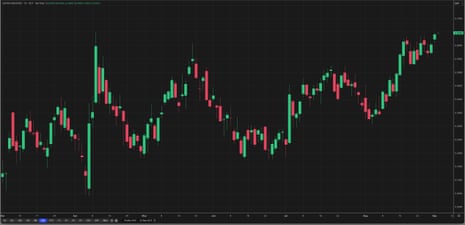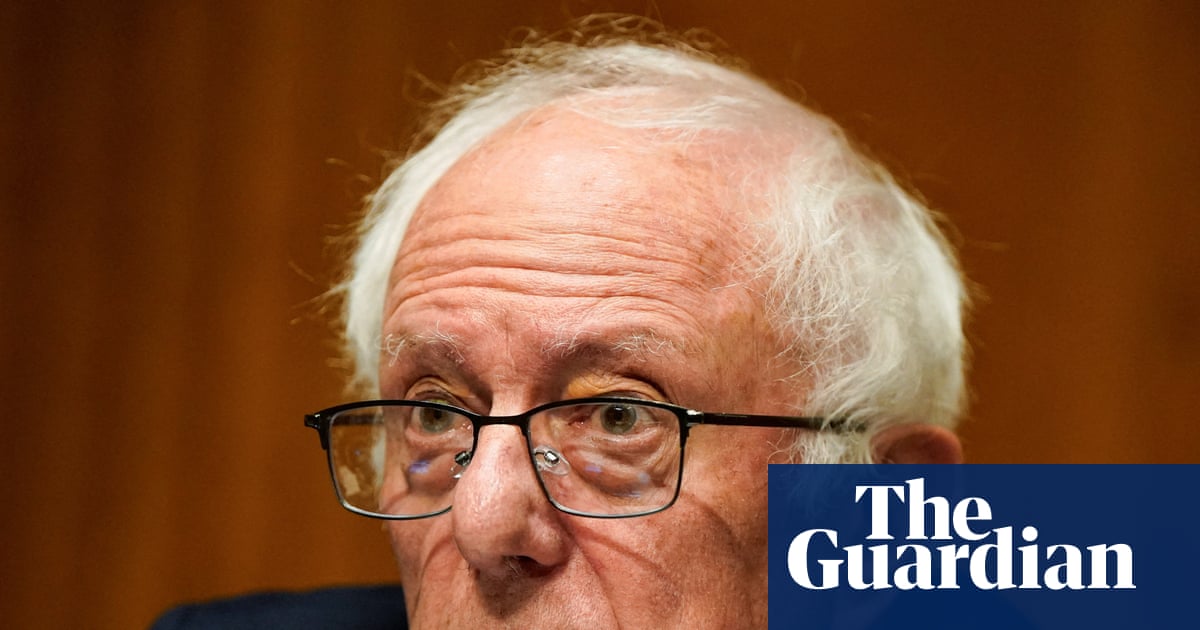UK long-term borrowing costs on brink of 27-year high
Good morning, and welcome to our rolling coverage of business, the financial markets and the world economy.
The bond vigilantes are back, piling pressure on governments in London and Paris amid fears over fiscal sustainability.
The UK’s long-term cost of borrowing is on the verge of hitting its highest level since 1998. Yesterday the yield, or interest rate, on Britain’s 30-year debt rose as high as 5.646%, just a whisker from the 27-year high of 5.649% set during trading on 9th April.

That pushes up the cost of adding to Britain’s national debt, eating into the headroom available to chancellor Rachel Reeves as she draws up the autumn budget.
Bond vigilantes punish governments for what they consider to be bad policy choices, by shunning debt auctions or by demanding higher and higher rates of return before buying government bonds.
Fiscal concerns have been pushing up long-term borrowing costs globally in recent weeks; September is traditionally a tough month for the bond markets, so the next few weeks could be volatile.
UK debt is in the firing line due to fears that the economy will slow later this year, and that Reeves faces a budget black hole that will need to be filled through either tax rises or spending cuts.
As Deutsche Bank’s chief UK economist, Sanjay Raja, told clients:
At the risk of sounding a little dramatic, the Autumn Budget will be a defining moment for the UK. On our estimates, a fiscal hole worth GBP 20-25bn will need to be filled in November.
Kathleen Brooks of XTB says August was “dreadful” for UK bonds, explaining:
This summer’s drip feed of potential tax rises has not gone over well with voters, and Labour has been hemorrhaging support to Reform in recent weeks. Essentially voters don’t want tax rises, while Labour backbenchers don’t want spending cuts, but something will have to give.
Political turmoil in Paris has pushed France’s bond yields higher in recent weeks too, widening the gap with Germany. The French government could fall next week, if it loses a confidence vote called over unpopular spending cuts.
French 30-year bond yields hit a multi-year high of nearly 4.5% yesterday.
France's 30-year government bond yield is now the highest since 2008 (green). We're in a new world. COVID landed us with a global debt overhang. There's no room for big deficits now, because markets' appetite for more debt is low. The right response is to reform. Not cap yields. pic.twitter.com/jzYuD4evLy
— Robin Brooks (@robin_j_brooks) September 1, 2025ING fear French bonds could continue to be pummelled by political uncertainty, telling clients:
The spread between French government bonds (OATs) and the German equivalent (Bunds) widened materially on the prospect of a confidence vote, and we still see the balance of risk tilted to further widening. The current 10Y spread is at a similar level to that seen in July 2024, when French President Emmanuel Macron called snap elections and OATs sold off significantly in response.
The agenda
-
10am Eurozone flash inflation reading for August
-
3pm BST: US manufacturing PMI report
Key events Show key events only Please turn on JavaScript to use this feature
The bad news for finance ministers, such as Rachel Reeves, is that September has a track record as a bad month for long-dated bonds.
Over the last decade, government bonds globally with maturities of over 10 years posted a median loss of 2% in September, according to data compiled by Bloomberg. That’s the worst monthly performance of the year. More here.
Japan sees strong demand at bond auction
Tokyo has fought off the bond vigilantes today, at a price!
An auction of Japan’s 10-year government bonds today has seen the strongest demand since October 2023.
Japan’s Ministry of Finance sold around 2.6 trillion yen (£13bn) of 10-year notes. Investors were attracted by elevated yield levels, with total bids nearly four times higher than the amount of debt on offer.
Bloomberg has more details;
The yield on the benchmark 10-year bond fell 2.5 basis points to 1.595% after touching 1.625% Monday, close to the highest since 2008, and bond futures gained after the auction result. The bid-to-cover ratio jumped to 3.92 from 3.06 at last month’s sale, comfortably above the 12-month average.
“The results were strong,” said Shuichi Ohsaki, a senior portfolio manager at Meiji Yasuda Asset Management’s fixed income management department.
“Given the high yield level at around 1.6% and the large-scale buying, bonds with maturities of 10 years or less are being bought, especially since the market had been cautious,” he said.
Traders have also been piling into silver, driving it over $40 per ounce for the first time since 2011.
KCM Trade’s chief market analyst, Tim Waterer, says:
“Silver is making a move higher in response to expectations of lower U.S. rates, while a tight supply market is helping to maintain an upward bias.”
Gold hits record high over $3,500/oz

The gold has hit a new alltime high, as traders turn to precious metals as a safe-haven asset in inflationary times.
While government bond prices are falling (driving up yields), the spot price of gold has climbed over the $3,500 mark to hit $3,508.50 an ounce early this morning, with investors flocking to this traditional safe-haven asset.
The rally comes as the markets anticipate interest rate cuts in the US later this year, which has weakened the dollar.
Traders have been piling into gold-focused exchange traded funds (ETFs), which lifts demand for the precious metals, while some central banks have been adding to their own holdings.
Worries about inflation have also lifted demand for gold, as Tony Sycamore, IG analyst, explains:
This week’s rally in gold and silver began mid-morning yesterday and coincided with a social media post by US President Trump who claimed that prices in the USA are “WAY DOWN” with virtually no inflation.
However, this narrative contrasts with recent economic data showing persistent inflationary pressures remain and comes as President Trump continues his dovish reshaping of the Fed Board as he pushes for sooner and deeper Fed interest rate cuts, into an economy which is growing at ~3.5% in Q3 according to the latest Atlanta Fed GDP Now reading
UK long-term borrowing costs on brink of 27-year high
Good morning, and welcome to our rolling coverage of business, the financial markets and the world economy.
The bond vigilantes are back, piling pressure on governments in London and Paris amid fears over fiscal sustainability.
The UK’s long-term cost of borrowing is on the verge of hitting its highest level since 1998. Yesterday the yield, or interest rate, on Britain’s 30-year debt rose as high as 5.646%, just a whisker from the 27-year high of 5.649% set during trading on 9th April.

That pushes up the cost of adding to Britain’s national debt, eating into the headroom available to chancellor Rachel Reeves as she draws up the autumn budget.
Bond vigilantes punish governments for what they consider to be bad policy choices, by shunning debt auctions or by demanding higher and higher rates of return before buying government bonds.
Fiscal concerns have been pushing up long-term borrowing costs globally in recent weeks; September is traditionally a tough month for the bond markets, so the next few weeks could be volatile.
UK debt is in the firing line due to fears that the economy will slow later this year, and that Reeves faces a budget black hole that will need to be filled through either tax rises or spending cuts.
As Deutsche Bank’s chief UK economist, Sanjay Raja, told clients:
At the risk of sounding a little dramatic, the Autumn Budget will be a defining moment for the UK. On our estimates, a fiscal hole worth GBP 20-25bn will need to be filled in November.
Kathleen Brooks of XTB says August was “dreadful” for UK bonds, explaining:
This summer’s drip feed of potential tax rises has not gone over well with voters, and Labour has been hemorrhaging support to Reform in recent weeks. Essentially voters don’t want tax rises, while Labour backbenchers don’t want spending cuts, but something will have to give.
Political turmoil in Paris has pushed France’s bond yields higher in recent weeks too, widening the gap with Germany. The French government could fall next week, if it loses a confidence vote called over unpopular spending cuts.
French 30-year bond yields hit a multi-year high of nearly 4.5% yesterday.
France's 30-year government bond yield is now the highest since 2008 (green). We're in a new world. COVID landed us with a global debt overhang. There's no room for big deficits now, because markets' appetite for more debt is low. The right response is to reform. Not cap yields. pic.twitter.com/jzYuD4evLy
— Robin Brooks (@robin_j_brooks) September 1, 2025ING fear French bonds could continue to be pummelled by political uncertainty, telling clients:
The spread between French government bonds (OATs) and the German equivalent (Bunds) widened materially on the prospect of a confidence vote, and we still see the balance of risk tilted to further widening. The current 10Y spread is at a similar level to that seen in July 2024, when French President Emmanuel Macron called snap elections and OATs sold off significantly in response.
The agenda
-
10am Eurozone flash inflation reading for August
-
3pm BST: US manufacturing PMI report

 3 months ago
51
3 months ago
51

















































